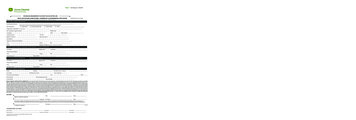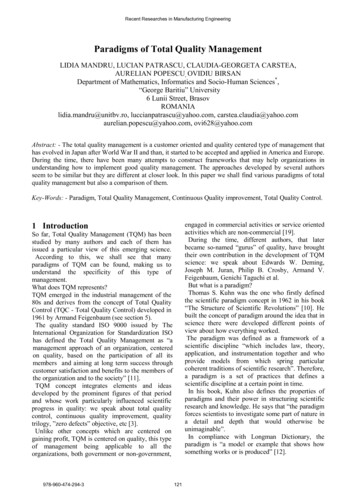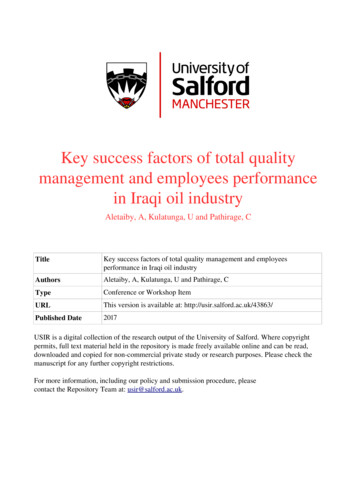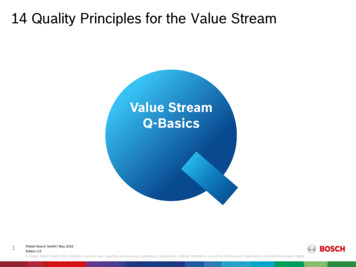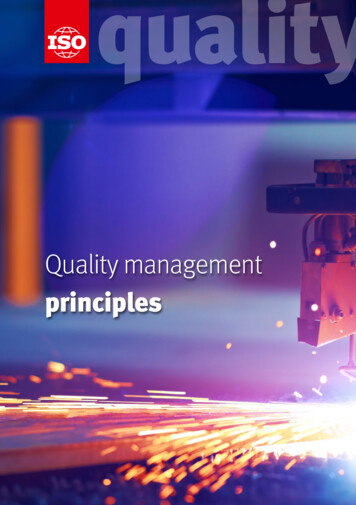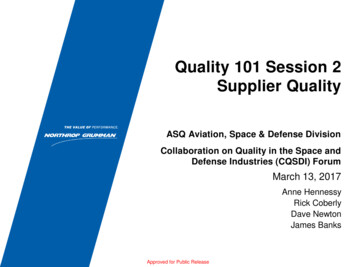
Transcription
PRINCIPLES OFotalualityTHIRDEDITIONVincent K. Omachonu, Ph.D.Joel E. Ross, Ph.D.CRC PR E S SBoca Raton London New York Washington, D.C.
This edition published in the Taylor & Francis e-Library, 2005.“To purchase your own copy of this or any of Taylor & Francis or Routledge’scollection of thousands of eBooks please go to www.eBookstore.tandf.co.uk.”Library of Congress Cataloging-in-Publication DataOmachonu, Vincent K.Principles of total quality / Vincent K. Omachonu, Joel E. Ross.--3rd ed.p. cm.Rev. ed. of: Principles of total quality / J.A. Swift, Joel E. Ross, Vincent K. Omachonu.Includes bibliographical references and index.ISBN 0-57444-326-7 (alk. paper)1.Total quality management. 2. Quality control. 3. Quality control--standards. I. Ross,Joel E. II. Swift, J.A. Principles of total quality. III. Title.HD62.15.O43 2004658.4′.013--dc222004041857This book contains information obtained from authentic and highly regarded sources. Reprinted materialis quoted with permission, and sources are indicated. A wide variety of references are listed. Reasonableefforts have been made to publish reliable data and information, but the author and the publisher cannotassume responsibility for the validity of all materials or for the consequences of their use.Neither this book nor any part may be reproduced or transmitted in any form or by any means, electronicor mechanical, including photocopying, microfilming, and recording, or by any information storage orretrieval system, without prior permission in writing from the publisher.The consent of CRC Press LLC does not extend to copying for general distribution, for promotion, forcreating new works, or for resale. Specific permission must be obtained in writing from CRC Press LLCfor such copying.Direct all inquiries to CRC Press LLC, 2000 N.W. Corporate Blvd., Boca Raton, Florida 33431.Trademark Notice: Product or corporate names may be trademarks or registered trademarks, and areused only for identification and explanation, without intent to infringe.Visit the CRC Press Web site at www.crcpress.com 2004 by CRC Press LLCNo claim to original U.S. Government worksInternational Standard Book Number 0-57444-326-7Library of Congress Card Number 2004041857ISBN 0-203-99813-8 Master e-book ISBN
TABLE OF CONTENTSSECTION I MANAGEMENT OF TOTAL QUALITY1 Total Quality Management and the Revival of Qualityin the U.S. .3The Concept of TQM 5Antecedents of Modern Quality Management 6The Quality Pioneers 7Accelerating Use of TQM 12Quality and Business Performance 13Service Quality vs. Product Quality 15Exercises 17Illustrative Case 18Questions 18Endnotes 18References 212 Leadership .23Attitude and Involvement of Top Management 26Communication 27How Employees Receive Information 27Culture 30Embedding a Culture of Quality 32Management Systems 33Control 35Exercises 37Illustrative Cases 37Questions 38Endnotes 38References 40iii
iv 䡲 Principles of Total Quality, Third Edition3 Information and Analysis .41Organizational Implications 41Information Technology 42Decision Making 43Information Systems in Japan 43Strategic Information Systems 44Environmental Analysis 45Shortcomings of Accounting Systems 45Organizational Linkages 47White-Collar Measures 49Advanced Processes/Systems 49Information and the Customer 51Information Needs 51The Information Systems Specialists 52The Chief Information Officer 52Systems Design 53Exercises 54Illustrative Case 54Questions 55Endnotes 55References 574 Strategic Quality Planning .59Strategy and the Strategic Planning Process 60Strategic Quality Management 62Mission 63Environment 65Product/Market Scope 65Differentiation 67Definition of Quality 68Which Approach(es)? 69Market Segmentation (Niche) Quality 70Objectives 70Supporting Policies 72Testing for Consistency of Policies 73Control 73Service Quality 74Summary 75Exercises 75Illustrative Cases 76Questions 76Endnotes 77References 795 Human Resource Development and Quality Management .81Involvement: A Central Idea of Human Resource Utilization 83Organizing for Involvement 84
Table of Contents 䡲 vTraining and Development 86Selection 87Performance Appraisal 88Compensation Systems 89Individual or Team Compensation? 90Summary 91Total Quality Oriented Human Resource Management 91Exercises 92Illustrative Cases 93Question 93Endnotes 94References 956 Management of Process Quality .97A Brief History of Quality Control 98Product Inspection vs. Process Control 100Moving from Inspection to Process Control 101Statistical Quality Control 102Basic Approach to Statistical Quality Control 103The Deming Cycle 103Manufacturing to Specification vs. Manufacturing to Reduce Variations 104Process Control in Service Industries 105Customer Defections: The Measure of Service Process Quality 105Process Control for Internal Services 106Quality Function Deployment 107Just-in-Time (JIT) 110Just-in-Time or Just-in-Case 112Benefits of JIT 113The Human Side of Process Control 114Exercises 115Illustrative Cases 115Question 116Endnotes 116References 1197 Customer Focus and Satisfaction .121Process vs. Customer 123Internal Customer Conflict 124Defining Quality 125A Quality Focus 125Break Points 126A Central Theme 127The Driver of Customer Satisfaction 127Getting Employee Input 128Measurement of Customer Satisfaction 129The Role of Marketing and Sales 130The Sales Process 131
vi 䡲 Principles of Total Quality, Third EditionService Quality and Customer Retention 131Customer Retention and Profitability 132Buyer–Supplier Relationships 133Exercises 135Illustrative Cases 136Questions 136Endnotes 137References 1398 Benchmarking .141The Evolution of Benchmarking 141Xerox 142Ford 143Motorola 143The Essence of Benchmarking 144Benchmarking and the Bottom Line 144The Benefits of Benchmarking 145Cultural Change 145Performance Improvement 145Human Resources 145Strategic Benchmarking 146Operational Benchmarking 148The Benchmarking Process 149Determine the Functions/Processes to Benchmark 149Select Key Performance Variables 149Identify the Best-in-Class 151Measure Your Own Performance 154Actions to Close the Gap 154Pitfalls of Benchmarking 154Exercises 155Illustrative Case 156Questions 156Endnotes 157References 1589 Organizing for Total Quality Management .159Organizing for TQM: The Systems Approach 160Organizing for Quality Implementation 165The People Dimension: Making the Transition from a Traditional to a TQMOrganization 168The Inverted Organizational Chart 169Internal Quality 169Roles in Organizational Transition to TQM 171Small Groups and Employee Involvement 172Teams for TQM 174Quality Circles 174Cross-Functional Teams 175
Table of Contents 䡲 viiExercises 177Illustrative Cases 177Question 177Endnotes 178References 18110 Quality and Productivity .183The Leverage of Productivity and Quality 185Management Systems vs. Technology 185Productivity in the United States 187Reasons for Slow Growth 187Measuring Productivity 189Basic Measures of Productivity: Ratio of Output to Input 189Total Productivity Measurement Model (TPM) 190White-Collar Productivity 192Measuring the Service Activity 192Improving Productivity (and Quality) 193Five Ways to Improve Productivity (and Quality) 195Examples of Increasing Productivity While Improving Quality 196Capital Equipment vs. Management Systems 197Activity Analysis 198Exercises 200Illustrative Case 200Question 201Endnotes 201References 20311 The Cost of Quality .205Cost of Quality Defined 205The Cost of Quality 206Three Views of Quality Costs 207Quality Costs 208Measuring Quality Costs 211The Use of Quality Cost Information 213Accounting Systems and Quality Management 214Activity-Based Costing 214The Multiproduct Problem 216Strategic Planning and Activity-Based Costing 217Summary 218Exercises 218Endnotes 218References 221SECTION II PROCESSES AND QUALITY TOOLS12 The Concept of a Process .225What is a Process? 225
viii 䡲 Principles of Total Quality, Third EditionExamples of Processes 226Types of Processes 228The Total Process 228The Feedback Loop 229Exercises 229References 23013 Understanding Data .231Introduction 231Data and Information 231The Concept of a Dashboard 232Significance of Data 232Deciding What to Measure 233Questions to Ask Prior to Data Collection 233Data Collection Methods 233Types of Data 234Data Reliability 235Stratification 235How to Present/Describe Data 237Visual Description: Tabular Displays 237Visual Description: Graphical Displays 237Numerical Description 238Sampling 241Basic Definitions 241Types of Sampling 242Sampling Error 246Summary 247Exercises 248Endnotes 248References 24814 The Seven Basic Quality Control Tools .251Background 251Check Sheets 252Defect-Location Check Sheets 253Tally Check Sheet 253Defect-Cause Check Sheet 254Flowcharts 256Graphs 256Line Graph 256Bar Graphs 257Circle Graph 259Histograms 260Pareto Charts 260Cause-and-Effect Diagrams 262Dispersion Analysis Cause-and-Effect Diagram 265Production Process Classification Cause-and-Effect Diagram 265
Table of Contents 䡲 ixCause Enumeration Cause-and-Effect Diagram 269Scatter Diagrams 269Control Charts 269Exercises 271Endnotes 273References 27315 Control Charts for Variables .275Background 275Uses of Control Charts 275Variables Control Charts 276Applications of Variables Control Charts 277Preparing to Use Variables Control Charts 277Problem Definition 278Choice of Quality Characteristic 278Size and Number of Samples 278Sampling Frequency 279Rational Subgroups 279Choice of Control Limits 279Collecting the Samples 279Examples of Variables Control Charts 280Example 1: X and R Charts 280Example 2: X and S Charts 282Example 3: X and MR Charts 284Interpreting Control Charts 287Summary 290Exercises 290Questions 290Problems 290References 292Appendix A 29416 Control Charts for Attributes .295Control Chart for Fraction Non-Conforming (p Chart) 296Example 1 297Example 2 300Control Chart for Number Non-Conforming (np Chart) 301Example 3 302Control Chart for Non-Conformities 304c Chart 304Example 4 305u Chart 306Example 5 307Summary 309Exercises 309Questions 309Problems 310
x 䡲 Principles of Total Quality, Third EditionReferences 31217 When to Use the Different Control Charts .313Introduction 313Example 1 313Solution 315Example 2 315Solution 315Example 3 315Solution 315Summary 315Exercises 31618 Quality Improvement Stories .319What Is a Quality Improvement Story? 319Step 1: Identify the Problem Area 321Step 2: Observe and Identify Causes of the Problem 321Step 3: Analyze, Identify, and Verify Root Cause(s) of the Problem 321Step 4: Plan and Implement Preventive Action 322Purpose 322Step 5: Check Effectiveness of Action Taken 323Step 6: Standardize Process Improvement 323Step 7: Determine Future Action 324Other Considerations 324Time Frame 324Quality Improvement Story Requirements 324QI Story Line 326Data Collection 328What Data Will the Team Need? 328Exercises 329References 32919 Quality Function Deployment .331History 331What Is Quality Function Deployment? 331Voice of the Customer 335A Case Study 335Customer Requirements 336Technical Requirement 337Strength of Relationships 337The Vertical Entries 3381. Importance Rating 3382. Surveying Company 3383. Chief Competitor 3384. Plan 3395. Rate of Improvement 3396. Absolute Weight 3397. Demanded Weight 339
Table of Contents 䡲 xiCompetitive Technical Assessment 3401. Total 3402. Percentage (%) 3403. Company Now 3404. Chief Competitor 3415. Plan 341Benefits 341Conclusion 342Exercises 342Endnotes 342References 343SECTION III CRITERIA FOR QUALITY PROGRAMS20 ISO 9000 .347ISO around the World 347ISO 9000 in the U.S. 349ISO 9000 351Components of ISO 9000 Standard Series 352Historical Perspectives 352Management Responsibility 353Functional Standards 355Benefits of ISO 9000 Certification 355Getting Certified: The Third-Party Audit 356Documentation 356Post-Certification 357Choosing an Accredited Registration Service 358ISO 9000 and Services 358The Cost of Certification 359ISO 9000 vs. the Baldrige Award 359Implementing the System 360Final Comments 360Exercises 361Endnotes 361References 36321 The Baldrige Award .365Endnotes 37022 QS-9000 .371Historical Perspective 371Basic QS-9000 371Structure of QS-9000 372Document Control and Registration 372Summary 373Exercises 373References 373
xii 䡲 Principles of Total Quality, Third Edition23 ISO 14000 .375Components of ISO 14000 375ISO 14001 377Registration 378Benefits 378Exercises 379References 37924 ISO 9000: A Practical Step-by-Step Approach .381Preparing for ISO 9000 Registration 381Pre-Audit Conducted 384Documenting Control Procedures and Work Activities 385Implementing a Policies and Procedures Training Program 386The Final Assessment 386GSP’s Recommendations for Achieving ISO 9000 387Exercises 388SECTION IV SPECIAL TOPIC
1.Total quality management. 2. Quality control. 3. Quality control--standards. I. Ross, Joel E. II. Swift, J.A. Principles of total quality. III. Title. HD62.15.O43 2004 658.4′.013--dc22 2004041857 This edition published in the Taylor & Francis e-Library, 2005. “To purchase your own copy of this or any of Taylor & Francis or Routledge’s collection of thousands of eBooks please go to www .
